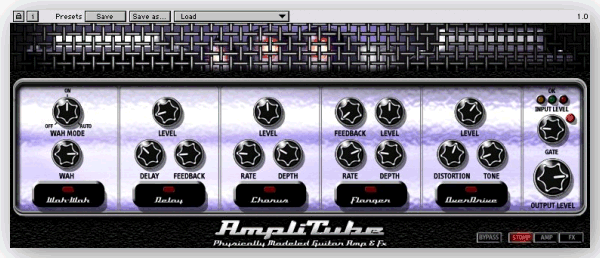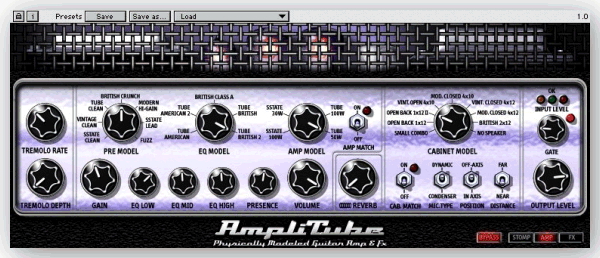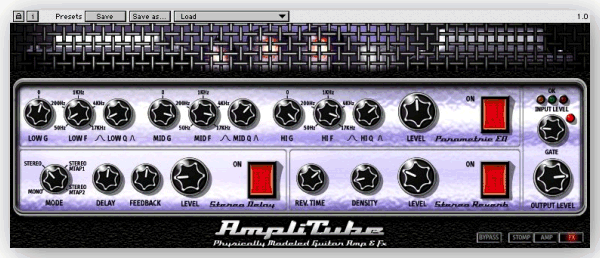AmpliTube

Those article was first written for Keyboards / Home Studio magazine. They are published here with their kind permission, thanks ,o)
Virtual synthesizers were in fashion, then virtual rhythm boxes, then virtual samplers etc. For some time, we have seen the arrival of new plug-ins which had the audacious ambition to replace our good old guitar amps, our effects pedal, and our racks. When we know how much guitarists love their stuff and their sound, this software needed urgent test to see what it is all about!
Authorization... to moan!
I will begin with a little aside about the software authorization mode. Installing Amplitube is like going round an assault course. First you have to decipher a dialog box where all is written with a very small font, get a code generated (depending on the computer), another code has to be copied on a little cardboard in the box. With these two codes, you have to go on the editor web site, enter many personal information to finally get a third code by email, which will be the one who will valid the installation. If you change your computer, you will have to do that again. If you don't have the internet, you have to send the elements by mail to the Editor in Italy, your final code will be addressed to you within 15 days! A bit restricting.
First approach...
Amplitube is a VST and RTAS/TDM plug-in which
wants to offer to guitarists the equivalent in software of what they use
everyday, pedals, preamp, amps and multi-effects. Nothing less!
The whole can be accessed through three very nice interfaces, but the readability is not quite good.
Stomp Module, the return of the effects pedals

Under this name are simply five effects pedals
as could be plugged between the guitar and the amp. We have under the
foot a Wha-Wha, a Delay, a Chorus, a Flanger and an Overdrive. Settings
are as simple and minimalists as on a pedal.
Globally, these effects are more than useful (with a restriction for the Wha-Wha which sounds a little as a duck), and really remind the pedals series of a famous Japanese constructor we could see at the foot of every guitarist before the racks advent. However, I would have liked to have a compressor in this section...
Amp Module, let's go to the market!

Let's see this interface. This one is the
most important because it is here that the sound will really be built.
After having passed through a very realistic
tremolo, the signal will come in the pre-amp section. You will find several
models which names are suggestive: Tube Clean, Vintage Clean, Solid State
Clean, Modern High Gain, etc. Then is a Eq section. There, no setting
is possible, we only have the choice between five models, which name are
suggestive too: Tube American, Tube British, British Class... Then, and
I have to admit that this really impressed me, we have a... spring reverb!!
Yes, you have well read it! The effect is really amazing, and we are waiting
for the screen to make a "shbloiiiiiiinnnnnngggg" when we move
it!
That's not all, we have built our sound,
but there remains the out power. Here is the Power Amp section, with four
models, two tube models (50 and 100W) and two transistor one (50 and 100W).
We can then choose our speakers between 9
models, from the small combo 15W to the 4x12, and a "no speaker".
That's not all! There is a last module, the
microphone which will take the sound of our amp. Dynamic or static ? In
the axis of the speaker or not ? Near or distant?
Thanks to marketing, the editor did not hesitate
to do this multiplication: 7 pre-amps x 5 Eq x 4 power amps x 9 speakers
= 1.260 possible combinations! That is mathematically true. But it remains
to verify that everyone has its usefulness.
Some elements, as the pre-amps or the speakers have a determining action on the global result, whereas others, as the power amps, have a far less perceptible. But, generally speaking, every parameter is precise and efficient.
Post FX Module which has its own effect!

To put the final touch to your sound, we just needed a little multi-effect, and here it is. Very modest, this part proposes nevertheless three essential effects: a parametric equalization, a stereo delay, and a reverb. Here again, few settings, but very efficient.
How does it sound?
Amplitube is bundled with some presets that
can be obtained through the "load" menu. We have to maintain
the mouse button hold during all the search in order to keep it open,
not handy at all. In the same way, we would have appreciated a system
to make scroll the presets rather than having to search for them in the
menu.
Using it, we quickly find that Amplitube
sounds better than not bad. I particularly appreciated clean and crunch
sounds. Plugging a Stratocaster in Amplitube is a real pleasure. The plug-in
properly reacts to the plectrum, and its comportment is really near from
its hardware equivalent. Moreover, the guitar grain is really respected,
if not turned to good account.
I would be more cautious concerning more
distorted or very distorted sounds. On one hand, the background noise
is enormous and makes that these sounds are hard to use, even with the
integrated Noise Gate. On the other hand, the saturation sounds very "transistor",
especially during solo.
But a rhythmic played once on the right and once on the left with a not too distorted sound will guarantee a huge sound!
Let's take advantage of it being a plug-in!
There is one thing that a plug-in can do that hardware cannot: the possibility to modify the sound after the recording! With Amplitube, it is the clean sound which is recorded on your HD. So you will be able to choose the sound which will be used in the mix when you want! I think that if software has an advantage in comparison with hardware, it will be tis one.
Being a guitarist, I have to admit that I
would have a certain tendency to be in bad faith as soon as I have to
talk about such software! But I have to say that Amplitube is more than
useful, apart the limits I told you earlier.
Amplitube is ideal for a musician who works
at home and who doesn't have the equipment necessary to a good recording,
or whose neighbours don't appreciate his high-level solo. But Amplitube
will also find its place towards the well-equipped guitarist because it
will bring him sounds that his (or her) equipment cannot bring him. To
be tested, without hesitation...
See you later, here or elsewhere ,o)
- Pros: clean and crunchy sounds
- Cons: restricting protection, background noise on very distorted sounds.
- Ergonomics : 17/20
- Sounds : 16/20
- Quality/Price ratio: 18/20
- Name : Amplitube
- Type : VST or RTAS/TDM Plug-in
- Genre : Amps and effects simulation for guitar
- Editor : IK Muyltimedia
- Distributor : Apacabar
- Minimum configuration:
- PC : Pentium III 500 MHz, 192 Mo RAM, Windows 95/98/ME/2000/XP
- MAC : G4, 192 Mo RAM, Mac OS 8.6 or 9
- PRO TOOLS : system Pro Tools, 192 Mo RAM, Mac OS 8.6 or 9, UC not specified
- Price : 310 €uros HT.





